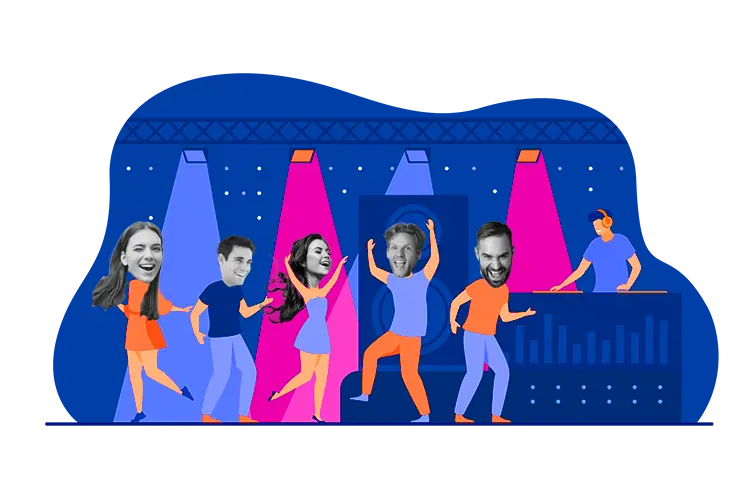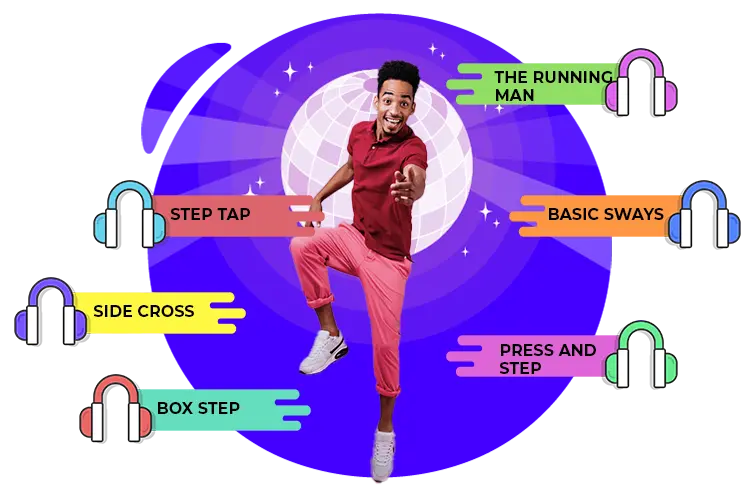
Nothing spells a successful wedding more than a packed dance floor. Dancing at the wedding is a chance not only to celebrate the newlyweds, but also an opportunity for guests to let loose after a long day.
If you’re like many people, though, you may feel a cold sweat come on the minute you think about busting a move. To help you feel more confident, we’ve compiled a complete guide about how to dance at a wedding, including the order of traditional dances and some basic moves to master before the big day.
So, whether you’re the one getting married or simply a guest, here’s how to find your groove.
After the vows and the wedding rings have been exchanged, it’s time to let loose at the wedding reception. The food and drinks are great, but the dancing is the true highlight.
From the first dance to the anniversary dance, there’s a lot to know, so let’s dive in.

As the name indicates, the wedding first dance gets the party started. Some newlyweds head to the dance floor as soon as the reception starts, as part of their grand entrance. However, most wait until after the cake cutting for this key moment. Usually, couples do a slow dance, but some like to shake things up by doing a choreographed number to an upbeat song.
Regardless of how you want to get down, if you’re the one kicking the party off with the first dance, spend some time choosing the perfect wedding first dance song. It could be a sentimental melody, a ballad you both love, or one you pick just for this occasion. There’s no right or wrong way to choose, so long as you make sure it’s something you both love and can dance to comfortably.
On a similar note, make sure you choose a song that’s between 2.5 and 3 minutes long. Shorter first dances won’t give you enough time in the spotlight, while something longer might stress you out.
When planning your wedding day dance, consider taking some wedding dance lessons a few weeks before the big day. You won’t become Fred Astaire or Ginger Rogers overnight, but learning a few moves will improve your confidence and make all the difference when it comes time for your big moment.
A local instructor can teach you some dance moves, or you can try online wedding dance lessons for even more convenience.
Following the first dance, many couples choose to have a parent dance.
There are tons of ways to do this. For example, the bride dances with her father while the groom dances with his mother-in-law. Alternatively, the bride’s mother and father can dance together while the groom dances with his mother.
This part of the traditional dance sequence lasts for one or two songs. The mood is upbeat or sentimental, depending on the couple’s wishes.
After the parents’ dance, the wedding party often has the opportunity to dance with the happy couple. Another option is to have members of the wedding party perform a dance number for the bride and groom. Either way, this part of the traditional dance sequence is pretty short, lasting for only one song.
After all the formal dances have concluded, the dance floor opens to wedding guests. Usually, the DJ will make an announcement to let the crowd know.


Once the dance floor opens up, it’s time to show off your moves. But what if you don’t know how to dance at a wedding reception? No problem!
Below, we’ve come up with a list of a dozen, easy-to-master moves that will help you confidently dance at weddings.
If you’re flying solo, here are some of the best dance moves you can do all by yourself.
It doesn’t get any simpler than this. Keep your feet in place while you move your upper body back and forth in time to the music.
Take one step to the side, tap your foot, then move back to the center and repeat on the other side.
Like the step tap, except you cross your outside foot over your other foot after taking a side step.
Form a “box” by crossing your right foot over your left foot, then stepping your left foot back, and finally stepping your right foot back.
Press your weight over one foot, then take a side step. Repeat on the other side.
Channel your inner bot by performing jerky mechanical movements with your arms and legs.
Run on the spot while moving one leg back and down.
If you have a partner, you can do even more moves. Remember that the follower usually starts with their right foot, and the leader starts with their left foot. Similarly, the follower holds out their right arm, and the leader holds out their left arm, when holding hands.
Sway while holding each other’s hands. This is an excellent move for slow dancing.
One partner takes two steps back, and the other partner takes two steps forward. Sway side to side, then switch your forward and backward steps.
Do a box step in place with your partner.
The same move as the solo step tap, just while holding hands.
One partner walks forward (right, left, right). The other walks backward (left, right, left). Bring the feet together and tap them on the fourth step.
March your feet on the spot while holding hands.

On top of learning some basic moves, it’s a good idea to know which line dances to expect at a wedding reception. In case you’re not familiar, a line dance is a choreographed sequence of steps performed in one or more rows.
A crowd favorite, the Macarena is a Latin pop song with corresponding dance moves like extending your arms in front of you, putting your hands on your head, and doing a quarter turn.
An extremely popular wedding line dance, the Electric Slide is a grapevine step to the right, followed by a grapevine step to the left. Then, move back and forth while swinging your arms, turn 90 degrees, and continue the pattern.
A newer line dance, the Cupid Shuffle tells you which moves to do, making it super-easy to follow. Take four steps to the right, then four steps to the left. Stand in place and kick your feet. Free dance when the lyrics say, “Walk it by yourself.” Do a quarter turn and repeat these steps.
If the thought of dancing makes your feet freeze in place or you’re unable to dance because of an injury or handicap, then feel free to skip this tradition. As with everything at your wedding, the decision of whether or not to have a first dance is up to you.
Most wedding receptions last about four hours. Of that time, about 1.5 to 2.5 hours should be dedicated to dancing. Anything shorter will put a damper on the party before it starts, while anything longer will have your guests begging for a break.
Whether you’re the one getting married or simply a guest, know that it’s totally fine not to dance. Ultimately, weddings are about having fun, so don’t do anything that you’re not excited about. Instead of dancing, play games, chat, or take advantage of the other fun activities at the wedding reception.
Even if you feel like you were born with two left feet, you can feel more confident dancing at your wedding. Do your best to incorporate the above tips, but overall, remember to try your best and have fun.
More questions about making the most of your wedding day? Check out all TheGroomClub’s wedding resources.